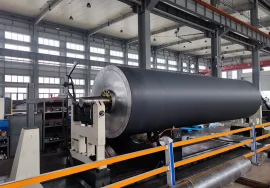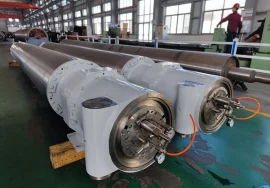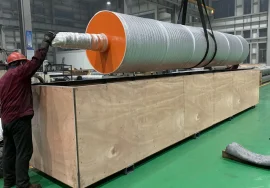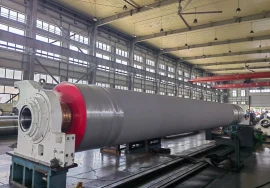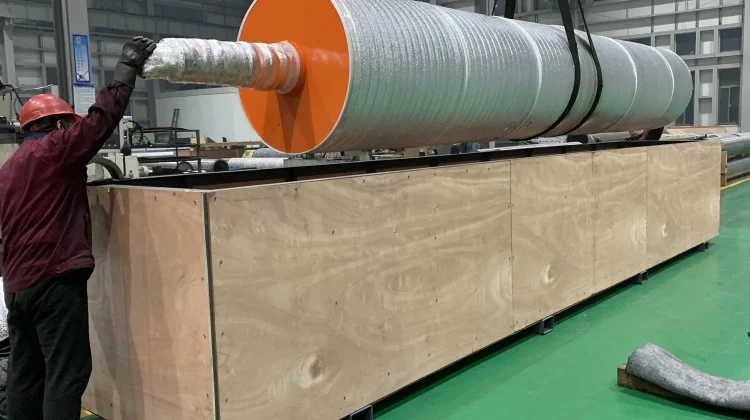
Boost Recycled Paper Quality with 304 SS Vacuum Press Rolls
In the demanding world of paper manufacturing, especially when working with recycled fibers, the efficiency and reliability of your machinery are paramount. Every component plays a critical role, and often, the performance bottleneck or a major source of downtime can be traced back to key spare parts. Among these vital components, the press section holds significant importance, tasked with removing substantial amounts of water before the drying stage. At the heart of this section, particularly in systems handling recycled pulp which can introduce various contaminants, is the vacuum press roll. It’s a complex part designed to apply pressure while simultaneously using vacuum suction to optimize dewatering. Ensuring this roll performs flawlessly is non-negotiable for consistent paper quality and operational efficiency. Frankly speaking, without a high-performing press roll, the entire production line suffers, leading to increased energy costs in drying, reduced machine speed, and potentially lower quality end product. This highlights why selecting the right materials for such components is not just a technical detail, but a strategic decision impacting profitability and sustainability. Specifically, the choice of a **304 Stainless Steel Vacuum Press Roll for Recycled Paper Machinery (Spare Part)** has become increasingly common due to its inherent properties that address the unique challenges presented by recycled fiber processing.
Understanding the Critical Role of Vacuum Press Rolls in Recycled Paper Lines
The press section in any paper machine serves a fundamental purpose: to mechanically remove water from the paper web, significantly reducing the energy required later in the thermal drying process. For recycled paper production, this step is even more crucial. Recycled pulp often contains a higher percentage of fines, fillers, and contaminants compared to virgin fiber, which can impede water removal. The vacuum press roll is specifically engineered to tackle this challenge. As the paper web passes through the nip between the vacuum press roll and another roll (often a plain press roll or a grooved roll), pressure is applied to squeeze water out. Simultaneously, vacuum is drawn through drilled holes or grooves in the vacuum roll’s shell, actively pulling water from the web and away from the nip. This vacuum action helps to prevent water reabsorption into the sheet after the nip and aids in consolidating the web structure. It’s a sophisticated mechanism requiring precise design and manufacturing tolerances to ensure uniform pressure distribution and effective vacuum performance across the entire width of the machine. The efficiency of this dewatering step directly impacts the moisture content entering the dryer section; a reduction of even 1-2% moisture here can translate into significant energy savings and a potential increase in machine speed. Therefore, the condition and material integrity of this roll are absolutely vital for achieving optimal production metrics in a recycled paper plant. Have you ever considered just how much energy is saved by efficient pressing?
Why 304 Stainless Steel is the Preferred Material for These Applications
When it comes to selecting materials for paper machine components, especially those exposed to the wet end and potentially corrosive environments, durability and resistance are key. Recycled paper processing can introduce various substances into the process water, including chemicals used in deinking, residual inks, adhesives, and organic acids generated by fiber degradation. These substances can create a corrosive environment that is particularly harsh on standard materials. This is where **304 stainless steel** shines. As an austenitic stainless steel, 304 offers excellent corrosion resistance due to its significant chromium content (typically 18%) and nickel content (typically 8%). This composition forms a passive oxide layer on the surface, protecting the underlying metal from oxidation and attack by many common chemicals found in paper mill white water systems. While not suitable for highly aggressive chloride environments or extreme pitting conditions where duplex or super austenitic grades might be necessary, 304 stainless steel provides a robust and cost-effective balance of corrosion resistance, strength, and machinability for most vacuum press roll applications, particularly those focused on recycled fiber. Its ability to withstand the chemical mix and abrasive nature of the fiber slurry without significant degradation ensures a longer service life for the roll shell, reducing the frequency of costly repairs, resurfacing, or replacement. This material choice is fundamental to the performance and longevity of a **304 Stainless Steel Vacuum Press Roll for Recycled Paper Machinery (Spare Part)**.
The Advantages of Using a High-Quality 304 Stainless Steel Vacuum Press Roll
Opting for a high-quality **304 Stainless Steel Vacuum Press Roll for Recycled Paper Machinery (Spare Part)** brings a multitude of advantages that directly translate into improved operational performance and reduced costs. Firstly, the superior corrosion resistance of 304 stainless steel means the roll shell is far less susceptible to chemical attack and pitting, common issues in recycled paper loops. This resistance helps maintain the integrity of the roll surface and drilled holes over time, ensuring consistent vacuum distribution and efficient dewatering. A consistent surface also leads to uniform pressure application across the web, crucial for preventing caliper variations and wet streaks in the paper sheet. Secondly, the inherent strength and hardness of stainless steel contribute to the roll’s durability, allowing it to withstand the significant loads and stresses encountered in the press nip. This robustness minimizes wear and deformation, extending the operational lifespan between maintenance intervals. Thirdly, the ability of 304 stainless steel to be precisely machined allows for tight manufacturing tolerances, ensuring the roll is perfectly balanced and true, which is essential for high-speed operation and minimizing vibration. Furthermore, a durable, corrosion-resistant roll requires less frequent resurfacing, reducing maintenance costs and machine downtime. In my experience, investing in a well-manufactured 304 stainless steel roll pays dividends through increased machine uptime, lower energy consumption in drying, and improved final paper quality. These benefits make it a wise investment compared to rolls made from less suitable materials that degrade more quickly in the challenging recycled paper environment.
Ensuring Optimal Performance: Maintenance and Care
While a high-quality **304 Stainless Steel Vacuum Press Roll for Recycled Paper Machinery (Spare Part)** offers excellent durability, proactive maintenance is crucial to maximize its lifespan and ensure continued optimal performance. Regular inspections are paramount. This includes checking the roll surface for any signs of wear, corrosion, pitting, or mechanical damage. The drilled holes or grooves must be inspected and cleaned regularly to prevent blockages caused by fiber or filler buildup, which can severely impact vacuum efficiency and lead to uneven dewatering. Cleaning procedures should utilize methods and chemicals compatible with 304 stainless steel to avoid damaging the passive layer. Mechanical checks, such as verifying bearing condition, roll balance, and nip uniformity, are also essential parts of a comprehensive maintenance program. Proper lubrication of associated bearings and seals according to manufacturer recommendations is critical. Furthermore, ensuring the vacuum system connected to the roll is operating correctly, with adequate vacuum levels and flow, directly affects the roll’s dewatering capability. Monitoring vibrations during operation can provide early warning signs of potential issues, such as imbalance or bearing problems, allowing for corrective action before catastrophic failure occurs. Implementing a stringent preventative maintenance schedule based on operating hours and visual inspections is key to safeguarding your investment and minimizing unexpected downtime. Maintaining the vacuum system and the roll’s physical condition are intertwined aspects of ensuring peak pressing performance.
Identifying the Need for a Replacement 304 Stainless Steel Vacuum Press Roll
Recognizing when your existing vacuum press roll is nearing the end of its useful life or is underperforming is essential for preventing production losses and potential damage to other machine components. Several indicators can signal the need for a replacement **304 Stainless Steel Vacuum Press Roll for Recycled Paper Machinery (Spare Part)**. A primary sign is a noticeable decrease in dewatering efficiency in the press section, leading to higher moisture content entering the dryer section and consequently, increased steam consumption or reduced machine speed. Visual inspection might reveal excessive wear, uneven surface profile, significant pitting, or corrosion on the roll shell that cannot be corrected by simple resurfacing. Worn or blocked vacuum holes/grooves that resist cleaning are another clear indicator of reduced performance and potential for sheet quality issues. Increased vibration during operation, even after balancing attempts, could point to shell deformation or internal issues. Changes in nip uniformity or pressure distribution that cannot be resolved through standard adjustments might suggest problems with the roll shell itself. Finally, catastrophic failure, such as a cracked shell or bearing seizure, obviously necessitates immediate replacement. Proactively identifying these signs through regular monitoring and inspection allows you to plan for a scheduled replacement, avoiding emergency shutdowns and the associated costs and production losses. It’s often more cost-effective in the long run to replace a worn roll than to continue operating an inefficient one.
Selecting the Right Supplier for Quality Spare Parts
Choosing the right supplier for a critical spare part like a **304 Stainless Steel Vacuum Press Roll for Recycled Paper Machinery** is just as important as selecting the material itself. A reputable supplier will not only offer rolls manufactured to precise specifications and high-quality standards but also provide technical expertise and support. Look for suppliers with a proven track record in paper machine component manufacturing, particularly those with experience in working with recycled paper applications. Quality manufacturing ensures the roll shell is cast or fabricated correctly, the drilling or grooving pattern is accurate, and the roll is balanced for smooth, high-speed operation. Consider suppliers who offer comprehensive services, including engineering consultation to ensure the replacement roll is correctly specified for your machine’s unique requirements and operating conditions. They should be able to provide detailed technical documentation, including material certifications for the 304 stainless steel used, manufacturing tolerances, and balancing reports. After-sales support, including installation guidance and troubleshooting assistance, can be invaluable. A reliable supplier understands the urgency of spare part needs in the paper industry and can offer reasonable lead times and efficient logistics. Don’t underestimate the value of a partner who can provide insights into common issues and best practices for maintaining your specific type of press roll. In my opinion, a strong relationship with a trusted supplier simplifies procurement and provides peace of mind.
The Impact on Paper Quality and Machine Efficiency
The performance of the **304 Stainless Steel Vacuum Press Roll for Recycled Paper Machinery (Spare Part)** has a direct and significant impact on both the quality of the final paper product and the overall efficiency of the paper machine. Efficient dewatering in the press section means less water enters the dryer section, which reduces the energy consumption per ton of paper produced – a major operational cost. This improved dewatering also allows for potentially higher machine speeds without overloading the dryers, increasing throughput and productivity. From a quality perspective, uniform pressure and effective vacuum across the web width are essential for achieving consistent paper caliper (thickness), moisture profile, and density. Uneven dewatering can lead to variations in sheet properties, affecting runnability and the final appearance and strength of the paper. A well-functioning vacuum press roll contributes to better sheet consolidation, potentially improving strength properties by promoting fiber bonding. Furthermore, the smooth, corrosion-resistant surface of a 304 stainless steel roll reduces the tendency for picking (fibers sticking to the roll surface), which can cause web breaks and defects in the sheet. Ensuring this critical component is in excellent condition is therefore fundamental to both maximizing production efficiency and consistently producing high-quality recycled paper. It’s worth noting that the long-term impact of efficient dewatering extends beyond immediate energy savings to include reduced wear on dryer fabrics and cylinders.
Considering Refurbishment vs. New Spare Parts
When faced with a worn vacuum press roll, paper mills often consider two primary options: refurbishing the existing roll or purchasing a new **304 Stainless Steel Vacuum Press Roll for Recycled Paper Machinery (Spare Part)**. Refurbishment typically involves services like resurfacing the roll shell, repairing or replacing damaged areas, and potentially re-drilling or cleaning vacuum holes/grooves. This can be a cost-effective option for rolls with minor wear or damage, especially if the roll shell is still within acceptable design limits regarding wall thickness and material integrity. However, it’s crucial to assess the extent of the wear and the remaining lifespan potential. Severe corrosion, deep pitting, or significant shell deformation might render refurbishment impractical or result in a roll with a significantly reduced future service life compared to a new one. A reputable supplier or service provider can perform a thorough inspection and assessment to determine if refurbishment is a viable option. Purchasing a new roll guarantees you receive a component manufactured to the latest specifications, using virgin materials (like high-grade 304 stainless steel) and benefitting from advancements in manufacturing techniques, balancing, and surface finishes. While the initial cost is higher, a new roll typically offers the longest possible service life and peak performance, providing the greatest return on investment over time through sustained efficiency and reduced downtime. The decision should be based on a careful analysis of the roll’s condition, the cost of refurbishment versus replacement, and the expected performance and lifespan of each option. Often, for critical applications in demanding recycled paper environments, the long-term benefits of a new, high-quality **304 stainless steel press roll** outweigh the initial cost savings of refurbishment.
In conclusion, the **304 Stainless Steel Vacuum Press Roll for Recycled Paper Machinery (Spare Part)** is far more than just a component; it is a performance-critical asset that directly influences operational efficiency, energy consumption, and the quality of the final recycled paper product. The unique challenges presented by recycled fiber processing demand a material that can withstand corrosive environments and abrasive conditions while maintaining dimensional stability and surface integrity. 304 stainless steel provides an excellent balance of properties for this application, offering robust corrosion resistance and durability. Ensuring you have a high-quality roll, whether as a planned replacement or a vital spare part inventory item, is key to minimizing downtime and maximizing productivity. Proactive maintenance, understanding the signs of wear, and partnering with a trusted supplier are all crucial steps in managing these essential components. Investing in quality ultimately pays off in sustained machine performance and consistent product quality. Take the time to assess the condition of your current vacuum press rolls and plan accordingly. A well-maintained or correctly replaced roll is a significant step towards optimizing your recycled paper production line.
For more detailed information, please visit our official website: 304 Stainless Steel Vacuum Press Roll for Recycled Paper Machinery (Spare Part)

